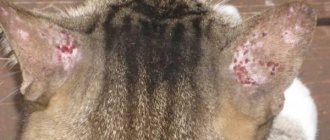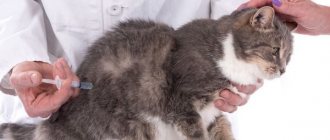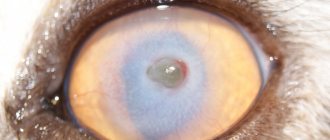Veronica Igorevna Sharipova
veterinarian Petstory
Papillomas in cats are a fairly rare pathology and are caused by infection with a special virus - papillomavirus. In general, papillomaviruses are DNA viruses that cause the formation of warts in various animal species, including humans. They are characterized by unusual, unpredictable behavior: warts can suddenly grow, then just as suddenly disappear, and then grow again. Papillomas develop after the virus penetrates the skin. Its thickening develops, followed by destruction of the normal structure of the skin and hyperkeratosis. Typically, such changes begin 4-6 weeks after infection.
Description of moles
Unfortunately, it is difficult even for a specialist to visually distinguish a benign formation, that is, a mole, from more serious formations. In addition, analyzing the questions of cat lovers addressed to veterinarians, it becomes clear that non-specialists mistake formations on the skin of a pet of varying degrees of malignancy for moles: papillomas, melanomas, hematosarcomas, squamous cell carcinoma. And even small lipomas and a tick attached to the animal.
- congenital and acquired;
- vascular and pigments;
- flat and slightly rising above the surface;
- By color, brown, black, and sometimes moles of other colors are also found;
- By size they are divided into: small (0.5-1.5 cm), medium size (1.5-10 cm), giant (more than 10 cm).
Moles are benign neoplasms; they rarely become malignant (malignant), but it is still possible. In this sense, giant moles are considered the most dangerous.
Diagnostics
Single or multiple warty growths found on the skin or mucous membranes of a cat can be of different nature. To make a diagnosis of papillomatosis, a laboratory examination of a fragment of a neoplasm taken during a biopsy using immunohistochemical staining and electron microscopy is performed. The cat is also given a blood test to check for Papillomaviridae virus DNA. The most reliable method is PCR using polymerase chain reaction, which allows detecting the virus even in a latent form.
Causes of moles
There is still debate about the reasons for the appearance of pigmented formations.
One theory is that it is a hereditary defect. Moles are congenital formations, but at first they are so small that they are simply not visible to the naked eye. Over time, under the influence of environmental factors, they increase in size and become noticeable.
Another theory attributes not only heredity to the causes of the phenomenon. That is, it is believed that some moles appear on the cat’s body, because this is embedded in the DNA. In addition, sunlight, or more precisely, the ultraviolet part of the spectrum, stimulates the movement of melanocytes to the epidermal layer of the cat’s skin.
Solar radiation, which is beneficial for plants, is harmful to the skin of mammals in excess amounts. It can affect the growth of pigment formations. X-ray radiation may also be a factor that will affect the growth of moles and even their malignancy.
Hormonal stress or disruptions resulting from pregnancy, castration, illness and other factors can affect the size of moles. Moreover, hormones, unlike other factors, can lead to both the appearance of pigment formations and their disappearance.
Predisposing factors
Scientists are still figuring out the causes of cancer and there is no final consensus on this matter. But there are a number of factors known that can weaken the body and indirectly provoke the development of cancerous tumors; below are some of the most significant of them:
- hereditary predisposition - skin cancer is more common in white animals, especially when exposed to irritation;
- hormonal imbalances, which in females can lead to breast cancer;
- ionizing radiation.
Dark spots
Quite often, attentive owners notice spots on their pets that they like to call “freckles.” What is it really and what does their appearance threaten the pet with?
Lentigo
In ginger cats and tortoiseshell animals, a skin defect occurs, which in medicine and veterinary medicine is called lentigo. These are dark spots, similar to pigment spots. Many veterinarians associate the appearance of lentigo in cats with the color of the animal.
The first spots are of medium size from 1 to 10 mm. Lentigo is a limited hyperchromia (increased pigmentation) of a melanocytic nature. The dark spots have clear contours and first appear when the pet is one year old. The usual location is the eyelids and lips. Later, more spots form on the animal’s nose and lips. Education does not apply to precancer. Most often, lentigo has no medical consequences. However, this formation can become malignant.
Vitiligo
In cats, there is also the disappearance of certain areas of pigmentation. This disease is called vitiligo. And it is hereditary. At the age of a kitten, vitiligo is not noticeable. Then, during adolescence, the cat develops discolored spots of varying sizes on its skin. Sometimes the coat and even the claws lose color. Most of the depigmented spots form on the animal's face. Over time, these spots may become cloudy. There are times when they disappear altogether, although this rarely happens. They do not cause any inconvenience to the animal and do not threaten its health.
How dangerous is papilloma for a cat?
When dangerous neoplasms are discovered, breeders are usually afraid of their malignant nature, i.e. They are afraid that their pet will be killed by cancer. In fact, this is not the only outcome of the situation. The problem is that large papillomas are well supplied with blood, especially those located on the mucous membrane, rich in blood vessels. If a cat damages such a wart, it may experience serious bleeding. In severe cases, it will be long-lasting.
As a result of large blood loss, chronic anemia can begin; in young animals, severe bleeding can be fatal. And even minor damage to a cat’s papilloma on the skin, invisible to the eye, can, under unfavorable conditions, lead to contagious inflammation. Warts that form on the paws and between the toes are especially susceptible to these unpleasant processes. No less suffering will befall the animal if the cat has papilloma in the ear, which is “attacked” by ear mites; the mixture of painful phenomena can provoke an inflammatory process that is difficult to treat.
Formations that are mistaken for moles
The formations that are mistaken for “hanging moles” and considered completely harmless have a very different nature. Some neoplasms really do not pose a threat to the life of the animal, while others are very dangerous and insidious.
Melanoma
One of the most insidious malignant tumors that “masquerades as moles” is melanoma. It also consists of melanocytes, like moles, but is not as harmless as they are. Melanomas are very aggressive tumors; they easily grow into deep tissues and even bone structures. They are difficult to treat, including surgical removal. When they appear, the prognosis is very doubtful. Fortunately for cats, such formations are rare.
Papillomas
These are benign tumors of viral etiology. Animals owe the growth of these formations to the papillomavirus. Papillomas are papillary-like skin formations or growths on the mucous membrane 1-3 cm in diameter. In cats, papillomas are most often colored black and have an uneven, spongy surface.
Most often, papillomas appear on the head in cats. Papillomas themselves are not dangerous. Their potential threat lies in their tendency to malignancy. Veterinary practice indicates that papillomas quite often become malignant. The risk of malignancy increases if papillomas form in the animal's mouth.
Hemangiosarcoma
This is a malignant neoplasm containing the walls of blood vessels, usually it is dark red, actually black. Hemangioma protrudes above the surface of the skin. Tumors are most often found on the animal’s head. This is explained by the effect of direct sunlight on this area. Fortunately for cats, this is a rare disease in cats, as the tumor is very aggressive and prone to metastasis.
Squamous cell skin cancer (carcinoma)
A malignant formation that is most often observed in the ear, nose and eyelids of an animal. It is believed that the appearance of carcinoma is due to prolonged exposure to ultraviolet radiation on the skin of the animal.
A red spot forms on the affected area of the animal, sores may appear, and hair may fall out. Ulcers heal with rough tissue. Usually the tumor is limited to healthy tissue. But metastases to the nearest lymph nodes and lungs are not excluded.
Lipoma
This is a benign neoplasm of the color of the skin of an animal, mobile, soft and painless. Consists of adipose tissue. As long as the tumor does not grow and does not compress surrounding tissues, it is not dangerous for the animal. In this case, a trip to the veterinarian is justified by the fact that a more aggressive formation can be mistaken for a lipoma or wen.
The head of the tick that has burrowed into the animal’s skin is not visible, and its body, swollen with the cat’s blood, resembles a papilloma or lipoma. Usually, experienced cat owners still distinguish ticks from neoplasms.
What is cancer?
Cells in a living organism constantly die, and new ones take their place. Cell division occurs through a phenomenon known as mitosis - when one mother cell divides into two others, with an even distribution of chromosomes.
When the process is disrupted, mutant cells appear that begin to divide uncontrollably at a high speed. These new cells form rapidly developing tissue, which inhibits healthy cells, suppresses and disrupts the functioning of organs and systems, depleting and weakening the entire body.
A healthy body under normal conditions destroys mutated cells, perceiving them as foreign, but sometimes this does not happen and either external or internal factors are favorable for the development of cancer cells. In this case, new growths arise, the malignant forms of which are known as cancerous tumors.
Treatment
Moles do not require any treatment or special care.
It is not advisable to injure them. And if this happens, then the healing process must be monitored carefully. Prolonged healing of the wound is a reason to contact a specialist. If large areas of skin are pigmented, then it is not advisable to allow long-term exposure to UV rays on your pet’s skin, since ultraviolet radiation is one of the causes of malignancy of moles.
When diagnosing another formation, treatment will be based on its type and aggressiveness.
Common warning signs
Early detection of cancer is critical to saving your pet. There are specific signs of the development of tumors of different types, but owners should be aware of some of the most important warning signs, the presence of which should immediately raise concern and raise suspicions of cancer. These are the warning signs:
- The presence of swelling on any part of the body that becomes larger, especially if the swelling is hot, red, painful, or the surface is ulcerated.
- Long-term non-healing wounds that do not respond to local treatment and antibiotics.
- Rapid weight loss, refusal to eat, general depression, weakness.
- Abnormal bowel movements, bad breath, rumbling in the stomach, vomiting.
- Strained cough, presence of blood in the sputum.
- Lameness, painful swelling on the limbs.
- Difficulty breathing, urinating or defecating, or any bloody discharge.
If any of these symptoms occur, you should immediately call an oncologist. Cancer develops rapidly, but if you contact a specialist early, the chances of saving your pet increase significantly.
Videos and Illustrations
Moles in animals
Moles
Lentigo
Papiloma
Hemangiosarcoma
Mites mistaken for moles
Melanoma
Squamous cell carcinoma of the ear
Vitiligo
CLICK THE LINK ASAP! ALL THE INFORMATION IS THERE -> https://azartplay777.ru/papilloms.cgi?19¶meter..
Moles Do cats have moles/freckles/birthmarks on their bodies? I mean, if you shave off the fur, what are the chances of them being found on the . . 30 Oct. G . - That is, it is believed that some moles appear on the cat’s body, because this is embedded in the DNA. In addition, sunlight, or rather . . Post by EnotJenya with tags Cat, Moles, Paws. Have something to tell? More than 2 million people visit Pikabu every day. Publish your . . Moles and other pigment spots in cats - symptoms, signs and causes of the disease, how to treat, what medications (tablets) to give, in what form. . Aug 16 G . — Mole on the Cat’s Belly vk /topic-65912995_35787084 · vk /topic-305200_35782921 · vk /topic- . . Aug 16 G . - says moles, but I noticed that many cats suffer from this. my cat (Teretsk Angora, white) appeared literally within a day on June 3, 18. G . — Good afternoon everyone, please tell me if anyone has come across this, my cat has something like a mole on her ear, my husband has a strong problem with this. . It is believed that cats have enviable health and easily tolerate any disease, but this is not true. Therefore, if you notice that the cat has become... . Moles are congenital formations, but at first they are so small that they are simply not visible to the naked eye. Over time, under . . In our section you will learn what vaccinations your cat will need, how to raise it correctly, and we will also tell you in detail about breeds and. . 23 05 — Home/Article/Dermatology/Pathologies accompanied by hyperpigmentation of the skin and fur in dogs and cats. . 29 Jun 2022 — The nose was always clean. But a week ago such a spot appeared on my nose. I tried to wash it, but it didn’t wash off. My husband says mole. 28 Nov G . - (Adriano Bacchella. Cats). Cat's paws deserve the closest attention and a separate story, they are so important. . 25 Jan G . — Cats are not only popular pets, but also... .
How to treat papilloma with folk remedies
Of course, it is better not to self-medicate your pet, placing this responsibility on the shoulders of professionals. But recipes from traditional healers can be useful in situations where veterinary care is simply not available to people. It is better to discuss the possibility of using folk remedies with a veterinary clinic specialist who has experience in treating papillomas, who will tell you whether you can use the recommendations given. So, supporters of alternative treatment for warts advise:
- lubricate their base with iodine solution;
- apply garlic juice to the papilloma every day for 1-3 weeks;
- Once a day, “burn” the wart with a drop of acetic acid;
- apply a paste of crushed rowan fruits to the papilloma 2 times daily;
- periodically lubricate the tumors with dandelion juice (this method will help cope with recently appeared small warts).
Locations
An increase in the growth of moles is observed in people aged 0 to 20 years, and then from 45 years and older. The rest of the time they appear, but not as actively as in the first and last phases of life. Typically, red moles appear on the upper body, arms, legs and shoulders. Their favorite places are also the head, feet, and hands. They can be located throughout the body, and it is impossible to predict their subsequent locations. Their red color comes from the accumulation of small blood vessels at the base, which supply them with blood.
Symptoms
Neoplasms in cats differ in that seals appear on the body. But it is quite difficult to notice them, since usually no one probes their animal every day.
When internal organs are damaged, significant changes in the pet’s condition are noted:
- disorders of the gastrointestinal tract;
- metabolic disorders;
- neurological symptoms;
- changes in blood composition;
- respiratory problems.
If a tumor in cats forms in the skin, its growth is slow. Metastasis is observed only in late stages. When a tumor grows on the mucous membranes, it grows faster and metastasizes to the lymph nodes. Melanoma in this case is prone to bleeding.
The tumor metastasizes through the blood or lymph. Those nodes that are located close to the formation are most often affected. Metastases into the dermis may be observed; they look like small dark rashes. Metastases that are transmitted through the blood can appear in various organs. The adrenal glands, brain, and liver are most often affected.
Shortness of breath may be a visible symptom of malignancy in cats over 10 years of age.
Features of the course of the disease
- Pigmented melanoma occurs in only 1% of cats.
- There is a tendency to dissemination; metastases occur both hematogenously and lymphogenously.
- The most aggressive tumor is considered to be localized at the junctions of the skin and mucous membrane, in the scrotum area, near the nail.
- Treatment should be given preference to surgical intervention, but for tumors larger than 3 cm, cryodestructive surgery is recommended.
- Melanoma in animals has not been fully studied. Radiation does not play a role here; the tumor most often occurs in areas of the skin hidden under the fur.
- The tumor is most often observed in males. Moreover, their age exceeds the 10-year threshold.
- Metastasis often affects regional lymph nodes and skin. The lesion can be recognized by its external sign - the presence of many brown or black rashes.
- There are 4 histological types of tumors: nevus-like, epithelioid cell, mixed cell, spindle cell. Variants of melanomas can be non-pigmented and pigmented.
Tumors in cats most often occur on the skin under the fur.









